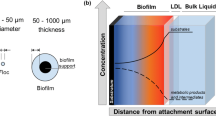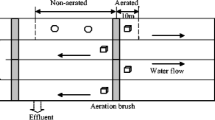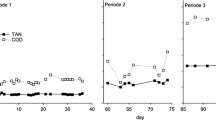Abstract
Wastewater treatment works can receive toxic substances that can kill microorganisms responsible for waste degradation. Implementation of toxicity monitors in-sewer, as part of an early warning system to help prevent toxic substances entering treatment works, is, however, very rare. This work presents results from a pilot-scale study using an in-sewer early warning system based on detection of nitrous oxide (N2O) gas emitted by nitrifying bacteria naturally present in sewer biofilm. Nitrous oxide has potential to be an indicator of nitrification inhibition as it is typically emitted when nitrifiers are under stress. The biofilm was allowed to develop over 14 days under fixed wastewater flow and level. Presence of nitrifying bacteria was verified on day 13 followed by a 90 min toxic shock on day 14 by four different known nitrification inhibitors. Pre-shock nitrification rates averaged 0.78 mg-NH4 +-N mg-VS−1 d−1 and were significantly reduced post shock to <0.2 mg-NH4 +-N mg-VS−1 d−1. Nitrous oxide emissions were found to vary with influent wastewater quality, suggesting a more complex data processing algorithm is needed instead of a simple threshold emission value. The extent of nitrification inhibition differed from the recorded response for suspended growth biomass with allylthiourea resulting in a 77 and 81 % nitrification inhibition for literature suspended growth EC50 and EC75 concentrations, respectively. Results from this study suggest nitrifying biofilms in closed pipes can be used as part of an early warning system but will likely require amplification of the response to be of practical use. Further research is required to better understand the biofilm response and calibrate the early warning system for differentiating its unique baseline from true toxicity events.




Similar content being viewed by others
References
Aboobakar, A., Cartmell, E., Stephenson, T., Jones, M., Vale, P., & Dotro, G. (2013). Nitrous oxide emissions and dissolved oxygen profiling in a full-scale nitrifying activated sludge treatment plant. Water Research, 47(2), 524–534.
Ahyerre, M., Chebbo, G., & Saad, M. (2001). Nature and dynamics of water sediment interfaced in combined sewers. Journal of Environmental Engineering, 127(3), 233–239.
APHA, AWWA and WEF. (2005). Standard methods for the examination of water and wastewater (21st ed.). Washington, D.C: American Public Health Association.
Baban, A., & Talinli, I. (2009). Modelling of organic matter removal and nitrification in sewer systems—an approach to wastewater treatment. Desalination, 246(1–3), 640–647.
Banasiak, R., Verhoeven, R., De Sutter, R., & Tait, S. (2005). The erosion behaviour of biologically active sewer sediment deposits: observations from a laboratory study. Water Research, 39(20), 5221–5231.
Burgess, J. E., Stuetz, R. M., Morton, S., & Stephenson, T. (2002). Dinitrogen oxide detection for process failure early warning systems. Water Science and Technology, 45(4–5), 247–254.
Butler, M. D., Wang, Y. Y., Cartmell, E., & Stephenson, T. (2009). Nitrous oxide emissions for early warning of biological nitrification failure in activated sludge. Water Research, 43(5), 1265–1272.
Butterworth, E., Dotro, G., Jones, M., Richards, A., Onunkwo, P., Narroway, Y., & Jefferson, B. (2013). Effect of artificial aeration on tertiary nitrification in a full-scale subsurface horizontal flow constructed wetland. Ecological Engineering, 54, 236–244.
Chen, G., Leung, D. H. W., & Hung, J. (2003). Biofilm in the sediment phase of a sanitary gravity sewer. Water Research, 37(11), 2784–2788.
Choung, Y., & Kim, H. (2000). Nutrient removal and ORP monitoring in the intermittent aeration system with continuous inflow. Environmental Technology, 21(4), 375–385.
Clemens, J., & Haas, B. (1997). Nitrous oxide emissions in sewer systems. Acta Hydrochimica et Hydrobiologica, 25(2), 96–99.
Colliver, B. B., & Stephenson, T. (2000). Production of nitrogen oxide and dinitrogen oxide by autotrophic nitrifiers. Biotechnology Advances, 18(3), 219–232.
Debruyn, W., Wevers, M., & van Rensbergen, J. (1994). The measurement of nitrous oxide emissions from sewage systems in Belgium. Fertiliser Research, 37(3), 201–205.
Desloover, J., Vlaeminck, S. E., Clauwaert, P., Verstraete, W., & Boon, N. (2012). Strategies to mitigate N2O emissions from biological nitrogen removal systems. Current Opinions in Biotechnology, 23(3), 474–482.
Dotro, G., Jefferson, B., Jones, M., Vale, P., Cartmell, E., & Stephenson, T. (2011). A review of the impact and potential of intermittent aeration on continuous flow nitrifying activated sludge. Environmental Technology, 32(15), 1685–1697.
Dulkadiroglu, H., Cokgor, E. U., Artan, N., & Orhon, D. (2005). The effect of temperature and sludge age on COD removal and nitrification in a moving bed sequencing batch biofilm reactor. Water Science and Technology, 51(11), 95–103.
Gernaey, K., Bogaert, H., Massone, A., Vanrolleghem, P., & Verstraete, W. (1997). On-line nitrification monitoring in activated sludge with a titrimetric sensor. Environmental Science and Technology, 31(8), 2350–2355.
Jiang, F., Leung, D. H., Li, S., Chen, G., Okabe, S., & van Loosdrecht, M. C. M. (2009). A biofilm model for prediction of pollutant transformation in sewers. Water Research, 43(13), 3187–3198.
Kim, S., Miyahara, M., Fushinobu, S., Wakagi, T., & Shoun, H. (2010). Nitrous oxide emission from nitrifying activated sludge dependent on denitrification by ammonia-oxidising bacteria. Bioresource Technology, 101(11), 3958–3963.
Martín-Cereceda, M., Pérez-Uz, B., Serrano, S., & Guinea, A. (2002). An integrated approach to analyse biofilms of a full scale wastewater treatment plant. Water Science and Technology, 46(1–2), 199–206.
Maruejouls, T., Vanrolleghem, P. A., Pelletier, G., & Lessard, P. (2012). A phenomenological retention tank model using settling velocity distributions. Water Research, 46(20), 6857–6867.
Nielsen, P. H., Raunkjaer, K., Norsker, N. H., Jensen, N. A., & Hvitved-Jacobsen, T. (1992). Transformation of wastewater in sewer systems—a review. Water Science and Technology, 25(6), 17–31.
Nogueira, R., Melo, L. F., Purkhold, U., Wuertz, S., & Wagner, M. (2002). Nitrifying and heterotrophic population dynamics in biofilm reactors: effects of hydraulic retention time and the presence of organic carbon. Water Research, 36(2), 469–481.
Pagga, U., Bachner, J., & Strotmann, U. (2006). Inhibition of nitrification in laboratory tests and model wastewater treatment plants. Chemosphere, 65(1), 1–8.
Short, M. D., Daikeler, A., Peters, G. M., Mann, K., Ashbolt, N. J., Stuetz, R. M., & Peirson, W. L. (2014). Municipal gravity sewers: an unrecognised source of nitrous oxide. Science of the Total Environment, 468–469, 211–218.
Skipworth, P. J., Tait, S. J., Saul, A .J. (2000). The first foul flush in combined sewers: an investigation of the causes. Urban water 2(4): 317–325.
Stein, L. Y., & Klotz, M. G. (2011). Nitrifying and denitrifying pathways of methanotrophic bacteria. Biochemical Society Transactions, 39(6), 1826–1831.
Stephenson, T., Aboobakar, A., Black, G., Vale, P., Johnson, N., Harnett, R., Wang, Y., Cartmell, E., & Dotro, G. (2013). Nitrous oxide emissions from wastewater: challenging assumptions. 10th IWA Leading Edge Conference on Water and Wastewater Technologies, 2 - 6 June 2013, Bordeaux, France.
Utility Week. (2009). Upstream cyanide pollution caused severn trent sewage spill - Update, available at: http://www.utilityweek.co.uk/news/news_story.asp?id=70314&title=Upstream+cyanide+pollution+caused+Severn+Trent+sewage+spill+-+UPDATE (accessed August 10 2011).
Acknowledgments
The authors would like to thank the EPSRC, Severn Trent Water Ltd. and United Utilities PLC for their financial and technical support.
Author information
Authors and Affiliations
Corresponding author
Electronic supplementary material
Below is the link to the electronic supplementary material.
Appendix I
N2O emissions (90 point moving average applied to raw data) time series comparing biofilms conditioned with real and synthetic sewage on all pipes. ATU toxic shock applied at hour 24. (XLSX 209 kb)
Appendix II
N2O emissions (90 point moving average applied to raw data) time series comparing biofilms conditioned with real and synthetic sewage on all pipes. Chromium toxic shock applied at hour 24. (XLSX 108 kb)
Appendix III
N2O emissions (90 point moving average applied to raw data) time series comparing biofilms conditioned with real and synthetic sewage on all pipes. Copper toxic shock applied at hour 24. (XLSX 107 kb)
Appendix IV
N2O emissions (90 point moving average applied to raw data) time series comparing biofilms conditioned with real and synthetic sewage on all pipes. Nickel toxic shock applied at hour 24. (XLSX 109 kb)
Rights and permissions
About this article
Cite this article
Black, G., Jones, M., Vale, P. et al. Biofilm Responses to Toxic Shocks in Closed Pipes: Using Nitrous Oxide Emissions as an Early Warning of Toxicity Ahead of a Wastewater Treatment Works. Water Air Soil Pollut 225, 1837 (2014). https://doi.org/10.1007/s11270-013-1837-1
Received:
Accepted:
Published:
DOI: https://doi.org/10.1007/s11270-013-1837-1




